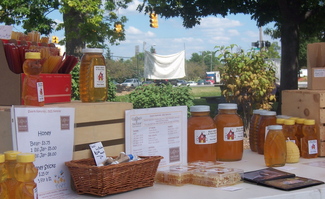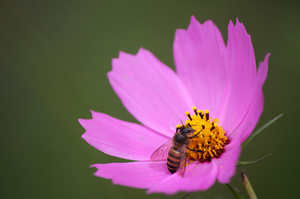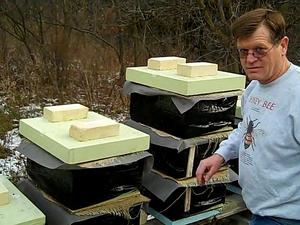Visit to Risk's Apiary & Honey House: home of Swarm Naturals
You may have noticed a newcomer to the aisles at Plum Market or Arbor Farms. Gleaming bottles of honey labeled Risk’s Apiary & Honey House or beeswax candles labeled Swarm Naturals now adorn the shelves.

Swarm Naturals and Risk's Apiary & Honey House display at the Westside Farmers Market.
Corinna Borden | Contributor
Angela started making beeswax candles, balms, and lotions from Mike’s honeycomb. I first met Angela as a wonderful edition to the Westside Farmers Market and they are now selling their combined efforts all over SE Michigan.
Visiting beehives in the winter is like visiting hibernating bears ~ not much is visibly happening, but there is a great deal one can learn regardless.
Mike Risk is the president of the Center of Michigan Beekeepers (COMB), the Lainsburg area beekeeping association. As a complete novice in the beekeeping world I felt I was being taught chopsticks by Mozart as Mike talked about breeding queens, Varroa mites, Nosema parasites, and Neonicotinoid pesticides.
It was an honor to have such a professional take a step back and answer my very rudimentary questions. Such as, “bees eat pollen from the flowers and turn that into honey?”

The bee drinks the nectar and collects the pollen into a pollen sac.
Photo by Flickr user kabils.
The honeycomb is the made from the nectar as well. The bees have 8 wax glands along the sides of their bodies. They create the mathematically perfect combs one fleck at a time. Pollen is turned into royal jelly, which is what is fed to a female larva to turn her into a queen. The queen lays eggs to populate and service the needs of the collective. She starts laying eggs in January to prepare for the season.
“How do bees survive the winter?”
Mike tells me there is a specific fat they have that allows them to survive for up to 6-9 months. The fat disappears once they start working in the fields, where the worker bees will literally work themselves to death. Worker bees are not the drones. “The drone has no function but to mate with the queen, they don’t do anything, they don’t collect honey, they hardly can feed themselves. They go and hang out in the afternoon to these “drone congregation areas" when the sun is warm.”
“When people talk about the importance of eating local honey - how local is local?”
As the one manning the booth at the farmer’s markets Angela smiles at this question. Mike replies. “If you have plant allergies that are a specific to a 2 mile radius around you than yes, you need bees to be making honey with that pollen - otherwise south-east Michigan has a very similar plant population.” When you process out the honey the pollen is removed through a very fine sieve.
Mike Risk's honey is raw and unprocessed. It will crystallize below 55 degrees. He does not use any chemicals to maintain his hives and his bees are not fed high fructose corn syrup.

Mike Risk checks on his nukes (a small hives of bees) next to his home.
Corinna Borden | Contributor
I also look forward to returning to Risk’s Apiary & Honey House in the summer to see the harvesting of the honey from their 50 hives and to see Angela turn their organic wax into candles for Swarm Naturals.
Drop me a line! Check out my website! Post a comment and start the conversation rolling!


Comments
Corinna Borden
Thu, Dec 17, 2009 : 10:25 p.m.
Hi Rosie, I was surprised when I found that out as well. Apparently a lot of beekeepers feed high fructose corn syrup to the bees when they are traveling (it is cheaper than sugar). Some people think that is contributing to colony collapse disorder epidemics.
Angela
Thu, Dec 17, 2009 : 9:36 p.m.
A surprisingly high amount of beekeepers feed HFCS to their bees in the winter.
Rosie
Thu, Dec 17, 2009 : 8:23 p.m.
When you said that his bees were not fed high fructose corn syrup was that meant to be humorous or do some beekeepers actually feed it to their bees?